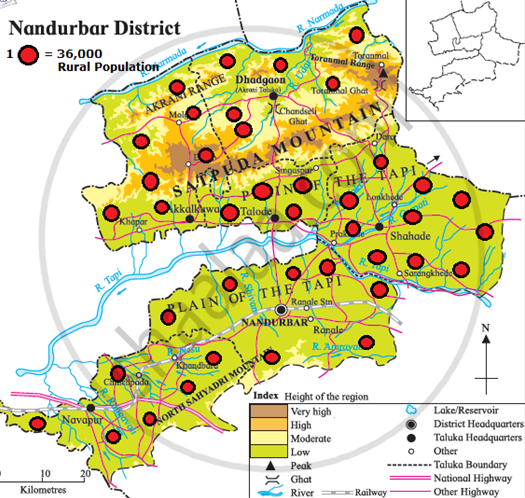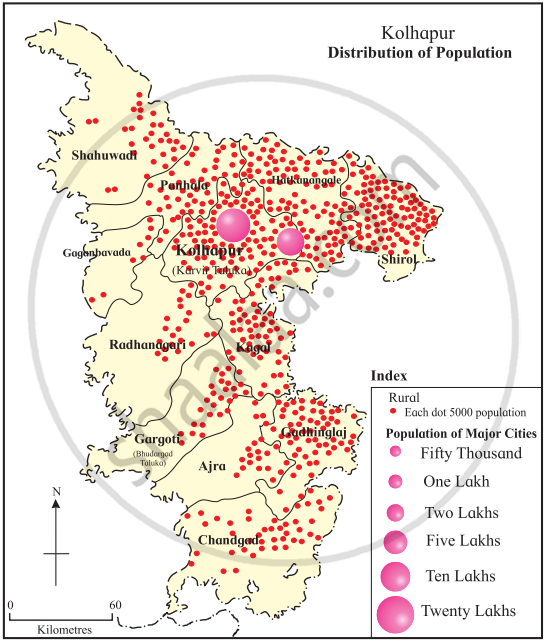Advertisements
Advertisements
Question
Now we will prepare a map using dot method. Carry out the following activity.
- See the map of Nandurbar given in fig. carefully. Draw it on another paper or tracing paper along with its taluka and district boundaries.
- Now see the population table given along the map. On the basis of the statistical data, decide the value of the dots considering the highest and the lowest values of population. For example, 1 dot = 10000 people, so you can decide how many dots to be given to each sub-administrative unit.
- To draw dots of the uniform size, take a ball pen refill. Close the back end of the refill with cotton. Press this end on a stamp-pad and draw the imprints of the dots wherever required.
- While placing the dots, consider the physiography, water sources, roads, rails, taluka and district headquarters as shown in the map in fig
- Compare your dot map with other students and arrange a discussion in the class

| S.No. | Talukas | Rural Population 2011 |
| 1. | Akkalkuwa | 2,15,974 |
| 2. | Akrani | 1,89,661 |
| 3. | Taloda | 1,33,291 |
| 4. | Shahada | 3,46,352 |
| 5. | Nandurbar | 2,56,409 |
| 6. | Nawapur | 2,31,134 |
Solution
To determine the value of a single dot in the above exercise, the highest and lowest rural populations of District Nandurbar for 2011 are considered. The following shows the calculation of a single dot value:
1 Single Dot = `("Highest rural population"-"Lowest rural population")/"Number of Talukas"`
1 Single Dot = `(346352 - 133291)/6`
1 Single Dot = 35510.17
1 Single Dot = 36000 rural population(approx.)
The following table shows how many dots each taluka should be given. This is arrived at through the following Equation =
36000 rural population is represented by 1 dot
Therefore, x rural population is represented by `(x)/36000` dots
| S.No. | Talukas | Rural Population 2011 |
No of dots`(x)/3600` | No of dots |
| 1. | Akkalkuwa | 2,15,974 | 5.9 | 6 |
| 2. | Akrani | 1,89,661 | 5.26 | 5 |
| 3. | Taloda | 1,33,291 | 3.70 | 4 |
| 4. | Shahada | 3,46,352 | 9.62 | 10 |
| 5. | Nandurbar | 2,56,409 | 7.12 | 7 |
| 6. | Nawapur | 2,31,134 | 6.42 | 6 |
Map with Dots:

Description:
From the above dot map, it is clear that the district of Nandurbar has a well-distributed rural population as per 2011 data. The lowest distribution is in Talode taluka, given its small area. The largest distribution is in Shahade taluka, which has many riverine basins. Sparse distribution can also be observed in the Akrani and Akkalkuwa talukas, with the Satpuda mountain ranges. Most of the rural population is in the talukas, which have several river basins running through them, like the Plain of the Tapi River.
APPEARS IN
RELATED QUESTIONS
Give reasons why following sentence is right or wrong:
The main aim of distributional maps is to show location.
Give reasons why following sentence is right or wrong:
In dot method, every dot should have an appropriate scale.
Give reasons why following sentence is right or wrong:
Distribution of various geographical elements can be shown using dot method.
Explain with reasons the method which is best suited to show the distribution of population in a region.
Which method will you use for the following information?
Talukawise wheat production in the district
Which method will you use for the following information?
Distribution of domestic animals in the State.
Study the population distribution map of Kolhapur district and answer the following questions:
- Which method has been used to show the distribution of population in the district?
- Explain the directionwise distribution of the population from dense to sparse.
- What is the population shown by the largest circle? Which place is that?
- Which Taluka has the least population?

